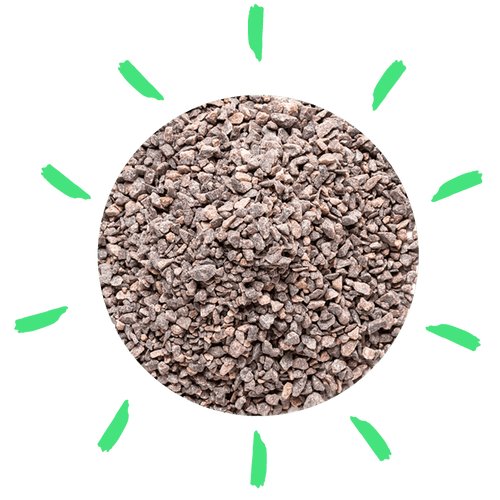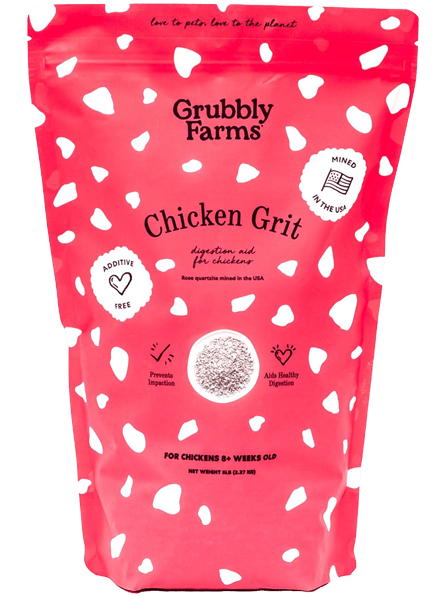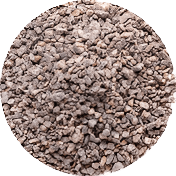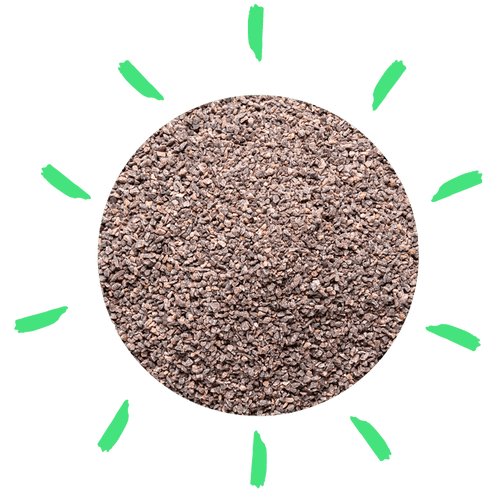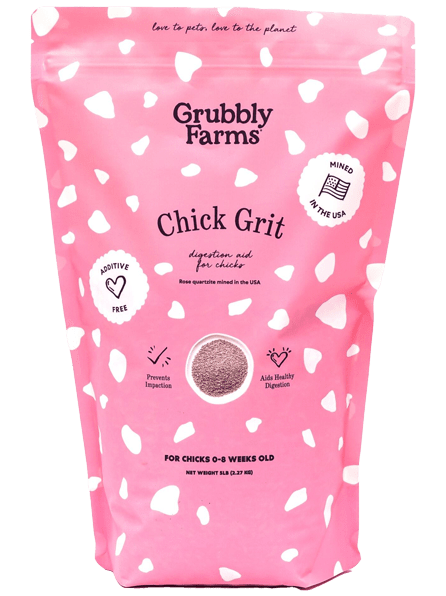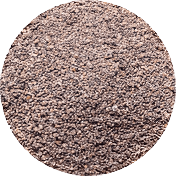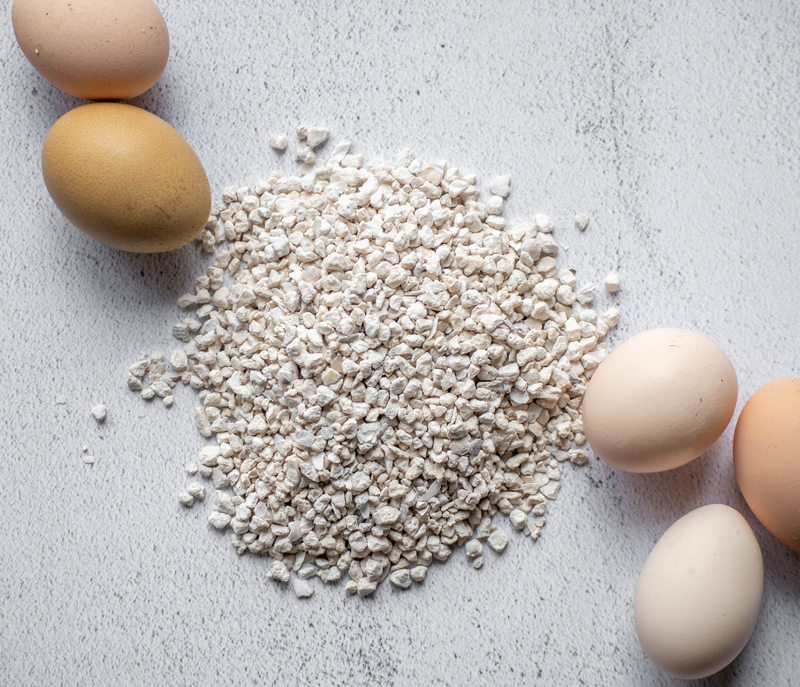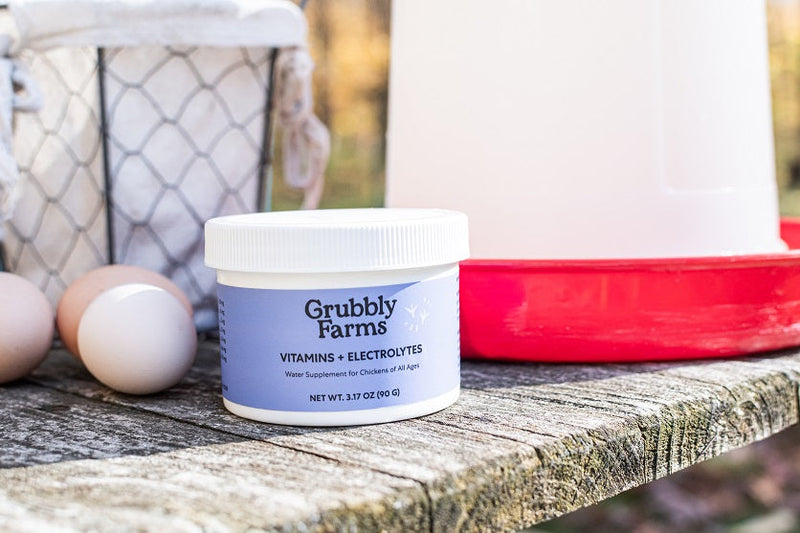Grit is an essential part of a chicken’s diet. Since chickens don’t have teeth, they use other methods of breaking down their food for digestion. Grit aids in the digestion of tough foods. Without grit, chickens can suffer from digestive issues, crop issues, and even become malnourished. Let’s discuss why grit is so important for chickens, how you can supply your flock with access to grit, and how to ensure you supply the appropriate type of grit for your backyard flock!

What is Grit for Chickens?
Chicken grit, also known as poultry grit, is basically small bits of coarse stone or gravel that chickens consume to aid digestion. Chickens swallow their food whole or in bite size pieces, and without teeth, that food needs to be broken down by something else within the digestive system. Grit contained in both the chicken’s crop and the gizzard take over the role of breaking down tough foods.
How Often Will Chickens Need Grit?
Chickens can naturally source grit from their environment. Free-range flocks often don’t need supplemental grit since they consume small pebbles and coarse dirt when they are foraging. However, confined chickens or chickens raised on pasture benefit from having constant access to supplemental grit.
There are three main ways that chickens can get different sources of grit in their diet:
- Flocks that can forage in a natural environment will supplement their diet with small stones, pebbles, and coarse dirt for grit in their diet.
- Insoluble Grit - Insoluble grit is supplemental grit that often comes in the form of small pieces of coarse granite or flint. This type of grit does not dissolve in the digestive system, but it does eventually wear down and needs to be replaced with more supplemental grit in the diet.
- Soluble Grit - Soluble grit, often in the form of oyster shells, is able to be dissolved during digestion and does not supply a long-lasting source of grit.
It is important to remember that while oyster shells can act as a form of grit in the digestion system, they are not tough enough to help a chicken digest tough food.
Differentiating Grit from Feed
Chicken grit is different than chicken feed. The chicken feed you give your flock should be a balanced and nutritious diet that supplies your flock with all the nutrients they need to stay healthy, active, and productive. Grit, on the other hand, is only a dietary supplement. It has no nutritional value and only serves the purpose of helping break down foods in the digestive system. Chickens who are fed a chicken feed consisting of only pellets or crumbles often don’t need supplemental grit. These forms of feed are processed and are soft enough for a chicken’s gizzard to break down without the aid of grit.
So, do chickens need grit in their diet if it doesn’t supply any nutritional value? Yes!
If any supplemental treats or snacks are added to your flock’s diet, grit will be necessary to help the chickens digest those foods. Chickens who are fed a whole grain diet need grit in order to help break down the whole grains in their chicken feed.

Why is Grit Important for Chickens
Grit acts as the grinding mechanism in a chicken’s digestive system. When a chicken is eating, it will swallow its food whole. If the food is too large to be swallowed comfortably, a chicken will often use its beak to try and break the food into more manageable size pieces that can be swallowed. Once the food enters a chicken’s beak, it is briefly softened by the chicken’s saliva before it is pushed down the throat by the chicken’s tongue.
Once the food has been swallowed, its first stop is the chicken’s crop. The crop is like a temporary holding place for food before it is sent on through the digestive system. Often times, small pieces of grit will remain in the crop to help start the process of breaking down food before it enters the stomach.
Once in the stomach, enzymes are added to the food to aid in breaking down the food and allowing nutrients to be absorbed. The food is then passed into the gizzard, which is the second muscular part of the stomach. It is an extremely tough, rubber-like bag that is flexible enough to accommodate large foods but also strong enough to churn and digest the food. When grit enters the gizzard, it cannot be broken down by the natural churning of the gizzard muscles. Instead, it remains in the gizzard to help break down other foods for further digestion.
Between the strong muscles of the gizzard and the coarse pieces of grit, any food in the gizzard gets thoroughly broken down into mush that can easily pass through the intestines where nutrient absorption occurs. Food that is properly broken down in the gizzard allows the nutrients in the food to be more readily absorbed.
Grit is essential in a chicken’s diet to keep the digestive system running smoothly and ensure proper nutrient absorption from the foods in a chicken’s diet. Food that is not broken down properly will remain in the crop or gizzard and start to ferment. Food that does not move through the digestive system properly can lead to sour crop, impacted crop, or impacted gizzard.

How Much Grit to Provide for Chickens
Different grades of grit will be needed for different ages of chickens. Young chickens don’t need as coarse a grit as adult chickens. However, all ages of chickens need grit in order to digest foods that are not soft enough to be digested on their own.
Do Chicks Need Grit?
Chicks who are fed only chick starter crumbles won’t need supplemental grit. The crumbles are soft enough to be easily digested without grit. If chicks are fed supplemental snacks or treats, they will need access to supplemental chick grit. Any kind of food, no matter how soft it is, other than chick crumbles will necessitate chick grit for your brood.
Chicks who have access to the outdoors and a natural environment will pick up natural sources of grit on their own. You can supply your chicks with access to natural grit by placing clods of grass or clumps of weeds or herbs in the brooder that still have dirt attached to the roots. You can also buy commercial chick grit or use builder’s sand as supplemental chick grit. Make sure you only use sand labeled as builder’s sand or construction grade sand for supplemental chick grit. Play sand is too fine and is often treated with chemicals.
What About Sand?
Chick grit has smaller particle sizes than regular grit, which is perfect for small beaks to manage. However, once the chicks are about 3 weeks of age, they will need to be supplied with a coarser source of grit. Bigger beaks mean bigger bites, and larger pieces of food necessitate coarser pieces of grit.
Young chickens who are over 3 weeks of age can be offered grower grit, which is coarser than chick grit. The young birds can stay on grower grit until they are about 2 months of age. Make sure the grower grit is not mixed with any calcium supplements, like crushed oyster shells. Calcium supplements are not needed until the young pullets start laying. Too much calcium in a young chicken’s diet can lead to kidney damage. Young birds who are allowed to forage will source out their own grit from the natural environment.
Once the chickens reach laying age, they can be switched to a regular layer grit or adult chicken grit. This grit is the coarsest grade of grit to ensure that the grit particles don’t just pass right through the chicken’s digestive system. Flocks who are allowed to forage will be able to pick up their own sources of coarse grit.
When giving chicks or chickens supplemental grit, make sure you always supply it as a free-choice supplement. Grit should not be mixed into your flock’s feed. By providing the grit as a free-choice supplement separate from your flock’s feed, it allows each individual bird to consume the specific amount of grit they need. Chickens will nibble at the supplemental grit as they see fit. Free-choice grit and calcium supplements are okay to mix together as long as you are only giving them to a flock of adult laying hens.
Different Types of Grit for Chickens

There are two main types of grit for chickens: insoluble grit and soluble grit.
Insoluble grit consists of coarse pieces of granite or flint. As the name implies, granite and flint will not dissolve in water or in a chicken’s stomach. These coarse rocks are too tough to digest and are retained in the chicken’s gizzard where they aid with digesting other tough foods.
Soluble grit sources are sources of grit that will eventually dissolve or be absorbed during the digestive process. The most common source of soluble grit for chickens is crushed oyster shells, however layer calcium is a more effective supplement offered alongside layer feed for laying hens. Unlike insoluble grit sources, oyster shells do add nutrition to the diet by supplying supplemental calcium that can be used for making strong eggshells and keeping a hen’s bones healthy and strong.
However, since oyster shells are soluble, they will not be effective for prolonged periods of time in the gizzard for digesting tough foods. Oyster shells should not be supplied as the sole source of grit for your flock. If you are feeding a laying flock, offer both supplemental oyster shells and layer grit to ensure your flock gets the coarse grit they need for proper digestive health.
FAQs about Chicken Grit
What if my chickens free-range, do they still need grit?
If your flock is free-ranging in a varied environment they will usually source grit from their surroundings, such as a driveway or gravel area. However, if your birds mostly have access to pasture, then supplemental grit may be necessary since fine soil or dirt is not coarse enough to act as grit for adult chickens.
Can I provide homemade grit for my chickens?
You can supply chicks with a natural source of chick grit by placing clumps of grass, weeds, or herbs in the brooder that still have dirt stuck to the roots. The dirt is fine enough to act as chick grit for your brood. Just make sure the grass, weeds, or herbs have not been treated with anything and are safe for your brood to consume.
For adult chicken grit, you can supply your flock with clean gravel that contains varying sizes of small stones and pebbles. However, granite grit is the most effective for adult chickens since it wears down very slowly in the gizzard.
How often should I replenish the grit?
You should refill the supplemental grit dispenser when it gets low. Your flock will peck through the grit as they need it, so you only need to refill it if the dispenser is getting low. The same applies to chick grit, refill the supplement dispenser when it gets low in the brooder.
Can chickens overconsume grit?
Adult chickens will naturally not overconsume grit. However, they may accidentally ingest too much grit if their treats or snacks are dumped on the ground where dirt and gravel can get stuck to the foods. If chickens consume too many fine particles of grit, such as sand or fine gravel, it can lead to crop impaction. To prevent accidental overconsumption of grit, feed your flock snacks and treats in a grassy area or keep their treats in bowls or trough instead of on the ground.
Chicks may be more inclined to overconsume chick grit out of curiosity. If you notice your chicks spending an abnormal amount of time around the grit dispenser, remove the dispenser and only supply them with chick grit when you are giving them extra treats or snacks.
Are there any alternatives to traditional grit for chickens?
The three most effective grit types for adult chickens are granite grit, flint grit, or coarse gravel. Any other substitutes may not be as effective for adding digestion and can even be dangerous. Using sand as grit for adult chickens should be avoided since the sand particles are too fine.

Conclusion
Chickens need grit in their diet to stay healthy! Grit aids with breaking down food in the crop and gizzard, which allows the chicken’s body to readily digest the foods and absorb the nutrients needed for survival. Free-range flocks will naturally forage for their own grit. Confined flocks or pasture-raised flocks benefit from having access to supplemental grit alongside their daily feed, treats, and healthy snacks. Feed your flock a balanced diet with the right supplements for healthy and productive chickens!







